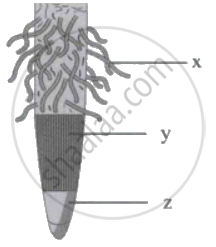Advertisements
Advertisements
प्रश्न
Describe structure of root hair.
उत्तर

- Root hair is a cytoplasmic extension (prolongation) of epiblema cell.
- Each root hair may be approximately 1 to 10 mm long and tube-like structure.
- It is colourless, unbranched, short-lived (ephemeral), and very delicate.
- It has a large central vacuole surrounded by a thin film of cytoplasm, plasma membrane, and thin cell wall, which is two-layered.
- Outer layer is composed of pectin and the inner layer is made up of cellulose.
- Cell wall of a root hair is freely permeable but the plasma membrane is selectively permeable.
APPEARS IN
संबंधित प्रश्न
Multiple Choice Question:
Put a tick mark (✓) against the correct alternative in the following statement:
The root-hairs are suited for absorbing water from the soil because:
Three plants (a), (b) and (c) were placed in beakers containing coloured water. The water in each beaker was covered with a layer of oil. The leaves were removed from plant (b), while plant (c) was exposed to strong light.
(i) In which plant, (a), (b) or (c) would the water move up the fastest?
(ii) In which plant (a), (b) or (c), would the water move up slowly?
(iii) Why was the water covered with a layer of oil?
(iv) What is being investigated by this experiment?

Choose the correct answer:
Process of ascent of sap in plants occurs ___________
The diagram below represents a layer of epidermal cells showing a fully grown root hair. Study the diagram and answer the questions that follow:

Draw a diagram of the above root hair cell as it would appear when a concentrated solution of fertilizers is added near it.
The below figure shows a root hair:
(i) Label the parts 1 to 4.
(ii) What is the role of part 4?
(iii) Why is the root hair one-celled?
(iv) What will happen to the root hair if some fertilizer is added to the soil near the root hair?
Name the following:
Name the process by which intact plants lose water in the form of droplets.
Most plant cells and tissues constitutes _____ % water.
Identify labels x, y, z in the given figure of root showing different regions.

____________ regions are present in a typical root.
Epiphytic plants like orchids absorb water vapours from air with the help of ______ having special tissue called velamen.
